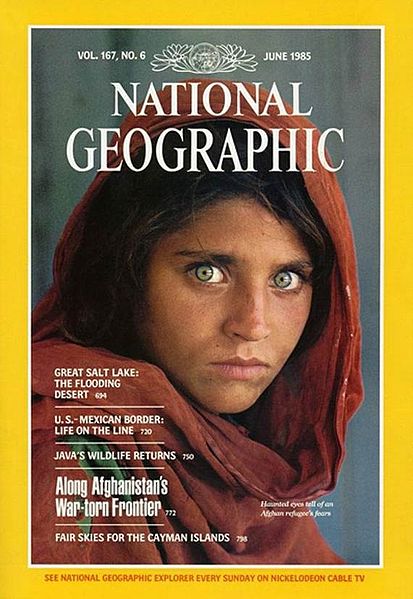One of the most famous photographs of the 20th century is the the National Geographic Afghan Girl. This story was originally published in Uncle John’s Slightly Irregular Bathroom Reader.
In December 1984, a National Geographic photographer named Steve McCurry visited the Nasir Bagh refugee camp on the Afghan/Pakistan border while covering the war between the Soviet Union and Afghanistan. While there he snapped a photograph of a 12-year-old girl with haunting blue-green eyes. The girl had been living in the camp ever since Soviet helicopters had bombed her village five years earlier, killing both her parents.
McCurry didn’t have a translator with him that day, so he never got the girl’s name. But the photograph, which appeared on the cover of the June 1985 issue, went on to become the single most recognized photograph in National Geographic’s 125-year history and one of the most reproduced images in the world.
NO FORWARDING ADDRESS
As the image’s fame grew, so did the mystery: Who was the girl?
“I don’t think a week has gone by for 15 years,” McCurry told National Geographic in 2002, “that I don’t get requests from people trying to get information about her.”
McCurry went on assignment to the region 10 more times in the years that followed, and each time he searched for the Afghan girl, but couldn’t find her. Then in January 2002, he and a team from National Geographic made one more trip to the Nasir Bagh refugee camp to try to track her down. The girl—who by then would have been a woman of about 30—apparently hadn’t lived in the camp for several years. But McCurry hoped they might find someone who knew her. The camp was scheduled to be demolished, so it was their last chance. Once Nasir Bagh was gone, there would be little hope of ever finding her.
COULD IT BE HER?
At the refugee camp the team pursued several false leads before finally meeting a man who claimed to recognize the girl in the photograph.
This guy seemed authentic. He said the woman was his neighbor’s wife and even offered to go and get her.
Several days later, the man returned with the woman’s husband.
In Afghanistan, women do not meet men other than family members, so McCurry was not allowed to see her. He sent a female member of the team, Carrie Regan, to photograph her face, so that it could be compared against the photos taken in 1984.
One look at the new photos was all it took. McCurry was certain that this woman, whose name was Sharbat Gula, was the same person he’d photographed 17 years earlier. But to be sure, he had photo analysts compare the irises of the girl in the 1984 photos with those of the woman in the 2002 photos. Result: They were 99.9% certain that Sharbat was the girl (an FBI analysis of her facial features came to the same conclusion). McCurry quickly negotiated with the family and not only received permission to meet Gula, but also to photograph her a second time for the April 2002 issue of National Geographic.
UPDATE
So what had happened to the “Afghan girl” in the intervening years? She had lived at Nasir Bagh until 1992 (she returned to Afghanistan during a lull in the fighting between the Soviets and Afghan rebels). She married a baker and had four daughters, one of whom died in infancy. Life for Gula had been hard and it showed in her face. Although only about 30 (she doesn’t know exactly when she was born), she looked much older. One thing hadn’t changed, though: “Her eyes are as haunting now as they were then,” says McCurry. And although Gula is the subject of one of the most famous photographs of the 20th century, it was only in 2002 that she saw the photo for the first time.
Gula has returned to her normal life. National Geographic provides medical assistance and other aid, and is seeing that her daughters receive an education. But the magazine will not reveal where she lives, ensuring that the girl with the haunting eyes will likely live out the rest of her life as she wishes—in anonymity, never to be heard from again.








